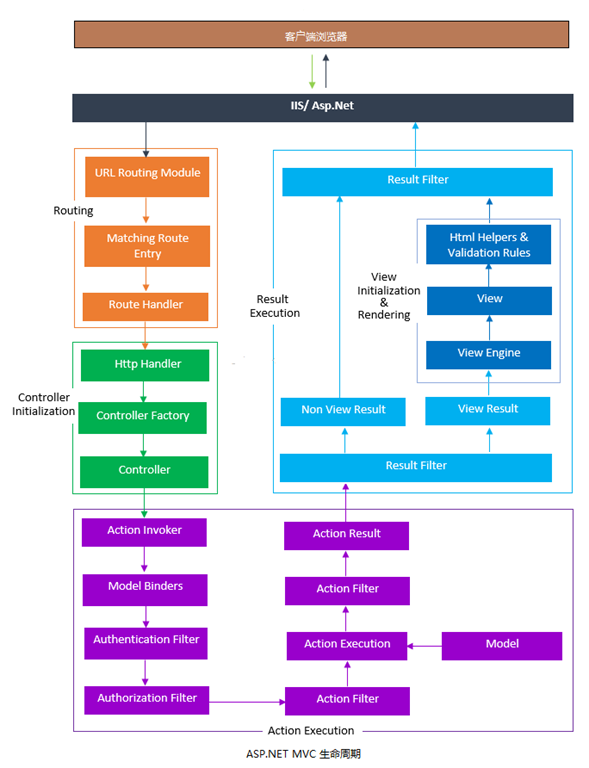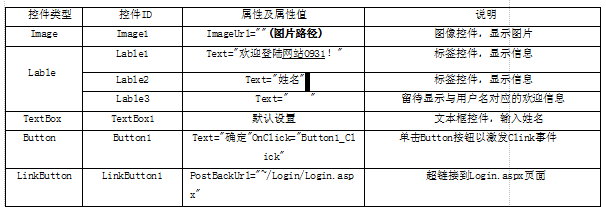ASP.NET Core 中的 Route 中间件的职责在于将 request 匹配到各自 Route 处理程序上,Route 分两种:基于约定 和 基本特性 模式。
基于约定 模式的Route采用集中化的方式,而 基于特性 的方式允许你在 Action 或者 Controller 上单独定义,到底采用哪一种可以基于你自己的应用场景,本篇就来讨论如何使用 基于特性 模式。
创建 Controller 类
创建一个 DefaultController 类,新增如下代码。
public class DefaultController : Controller
{
[Route("")]
[Route("Default")]
[Route("Default/Index")]
public ActionResult Index()
{
return new EmptyResult();
}
[Route("Default/GetRecordsById/{id}")]
public ActionResult GetRecordsById(int id)
{
string str = string.Format
("The id passed as parameter is: {0}", id);
return Ok(str);
}
}
Controller 级别定义 Route 特性
Route特性可用于 Controller 和 Action 级别,值得注意的是,如果应到到前者,那么 Controller 下的所有 Action 都受这个 Route 管控。
如果你仔细观察上面的 DefaultController 类代码,你会发现两个 Action 方法的 Route 路径都有 Default 前缀,这就不优雅了,优化方式就是把 Route 路径中的 Default 提取到 Controller 级别,代码如下:
[Route("Default")]
public class DefaultController : Controller
{
[Route("")]
[Route("Index")]
public ActionResult Index()
{
return new EmptyResult();
}
[HttpGet]
[Route("GetRecordsById/{id}")]
public ActionResult GetRecordsById(int id)
{
string str = string.Format("The id passed as parameter is: {0}", id);
return Ok(str);
}
}
可以看出当 Controller 和 Action 级别都被 Route 打上标记之后,Asp.Net Core 中的 Route 引擎会自动将两者拼接起来,当然更简单粗暴的做法就是在 Controller 上使用 RoutePrefix 特性,如下代码所示:
[RoutePrefix("services")]
public class HomeController : Controller
{
//Action methods
}
Action 级别定义 Route 特性
参考刚才的 DefaultController 类,我在 Index 方法上面定义了三个 Route 特性,这就意味着下面三种 Route 都可以访问到 Index() 方法,如下代码所示:
http://localhost:11277 http://localhost:11277/home http://localhost:11277/home/index
常常在 基于约定 模式的Route中,它的 Route template 会有一些对参数的约定,比如下面的代码:
app.UseEndpoints(endpoints =>
{
endpoints.MapControllerRoute(
name: "default",
pattern: "{controller=Home}/{action=Index}/{id?}");
});
同样 基于特性 模式的 Route 也是可以使用参数模式的,比如文章之前的 DefaultController.GetRecordsById 就是的,值得注意的是模板中的 {id} 表示可接收任何参数,如 string,int 等等,如果你想限定为 int 的话,也是可以实现的。
使用 Route 约束
Route 约束 就是 Controller 前的一个防火墙,他会踢掉一些不合规范的 Action 请求,比如说:你要求某个 Action 接收的参数必须是 int,那在 Route 模板中定义的语法格式一定是这样的 {parameter:constraint},如下代码所示:
[Route("Default/GetRecordsById/{id:int}")]
public ActionResult GetRecordsById(int id)
{
string str = string.Format("The id passed as parameter is: {0}", id);
return Ok(str);
}
在 Route 中使用可选参数
你也可以在 Route Template 上指定可选参数,意味着这个参数可传可不传,格式如下:
[Route("Sales/GetSalesByRegionId/{id?}")]
有一点非常重要,当你使用了 Route特性 之后,其实 Controller 或者 Action 的名字就不再重要了,因为 Route处理引擎 已经不再将其作为参考选项,下面的代码片段展示了如何在 Action 方法上变更 Route template 格式。
[Route("Home/GetRecordsById/{id:int}")]
public ActionResult GetRecordsById(int id)
{
string str = string.Format("The id passed as parameter is: {0}", id);
return Ok(str);
}
接下来可以直接使用如下地址访问 GetRecordsById 方法。
http://localhost:11277/home/GetRecordsById/1
对 Action 中的参数使用多个约束
真实场景中你不仅要求 id 必须是整数,还要求必须有一定意义,比如说最小值为1,对这种有 多重约束 的需求如何去实现呢? 请看下面代码。
[Route("Default/GetRecordsById/{id:int:min(1)}")]
public ActionResult GetRecordsById(int id)
{
string str = string.Format("The id passed as parameter is: {0}", id);
return Ok(str);
}
常使用的 Route 约束
- int 限定为 int 类型
- max/min 限定 int 的最大数和最小数
- minlength 限定 string 的最小长度
- regex 限定符合的正则
创建自定义的 Route 约束
如果上面的一些约束不满足你的要求,你完全可以为你的场景深度定制,做法就是使用 IRouteConstraint 接口并实现它的 Match 方法即可,如下代码所示:
public class CustomRouteConstraint : IRouteConstraint
{
public bool Match(HttpContext httpContext, IRouter route,
string routeKey,
RouteValueDictionary values, RouteDirection routeDirection)
{
throw new NotImplementedException();
}
}
在 Controller 上使用 token 占位符
所谓的 token 占位符 就是具有一些特定含义的占位符号,比如说:[action], [area] 和 [controller],分别表示用你真实的 Controller 和 Action 去替换,下面的代码展示了如何使用这种模式去实现。
[Route("[controller]/[action]")]
public class HomeController : Controller
{
private readonly ILogger<HomeController> _logger;
public HomeController(ILogger<HomeController> logger)
{
_logger = logger;
}
public IActionResult Index()
{
return View();
}
//Other action methods
}
整体来看,基于特性 的 Route 给了你更多的操控权限,灵活的 Route Template 配置实现了 Controller 和 Action 的解耦,当然这里也不是说 基于约定 的Route 不好,毕竟人家是 Global 级别的,真实场景下两者更多的是混着用。
译文链接:https://www.infoworld.com/article/3569369/how-to-use-attribute-routing-in-aspnet-core.html
到此这篇关于如何在ASP.NET Core中使用Route特性的文章就介绍到这了,更多相关ASP.NET Core Route特性内容请搜索以前的文章或继续浏览下面的相关文章希望大家以后多多支持!





